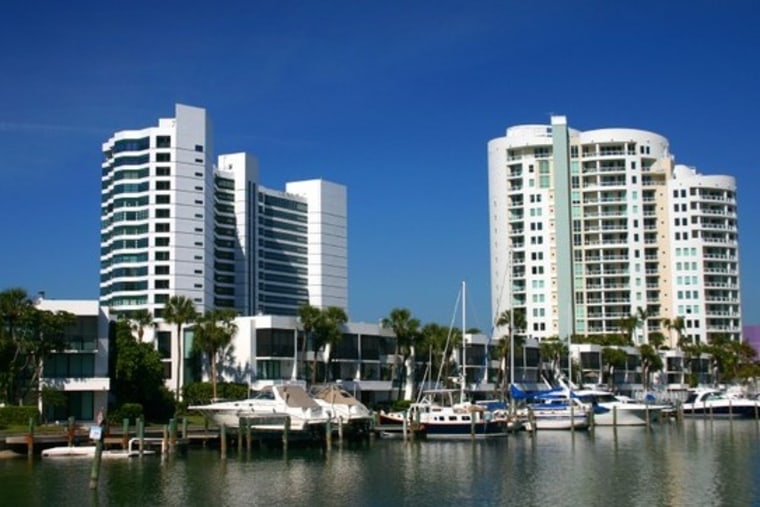Some of the Sunbelt cities hardest-hit by the housing bust could get a boost from a traditional flock of migrants — snowbirds and retirees — as well as residents of nearby bigger cities looking for cheaper housing.
Real estate listings site Trulia.com says a slew of metropolitan areas in Florida and California boast the highest proportion of home searches from people outside the area as compared to local residents searching for property elsewhere.
In an analysis of about 100 million searches on the site from July 1 through Sept. 30, Trulia tallied the location of users and where they were looking for homes. Trulia used Metropolitan Statistical Areas (MSAs) and Metropolitan Divisions, geographic areas defined by the U.S. Office of Management and Budget.
Forbes.com slideshow: Where Americans are hunting for homes
The result is an index, called the Metro Movers Report, suggesting which big real estate markets might get a boost from people moving there. “Where people are property searching is an indicator of which local markets are picking up strength and where demand is growing,” asserts Jed Kolko, chief economist and head of analytics at Trulia. Given that nearly 90 percent of all initial home searches begin online, Trulia may be onto something. A recent survey from the National Association of Realtors also found that 40 percent of homeowners who purchased their places between July 2010 and June 2011 found their place online.
All of the top 10 cities “picking up strength” are in the Sun Belt. Florida dominates the list with five snow bird hubs in the top 10: the North Port-Bradenton-Sarasota area (No.1), Fort Lauderdale-Pompano Beach (No. 4), Cape Coral-Fort Myers (No. 5), West Palm Beach-Boca Raton (No. 6), and Orlando-Kissimmee-Sanford (No. 10).
In Bradenton a little over six times as many people from outside the area were looking for properties there as the number of people living there looking for properties elsewhere; Fort Lauderdale had a ratio of 2.15 and West Palm Beach 2.09. Kolko says search data indicates that east coast Florida cities like Fort Lauderdale garner the most interest from Northeasterners, particularly those hailing from the New York City area; west coast Florida cities like Bradenton get high property search traffic from Midwesterners, particularly among Chicagoans.
Forbes.com: America’s doomed mansions
Another sign of improving health in the Florida real estate market: Existing home sales along the coasts picked up somewhat dramatically this year, even in the slower summer and early fall months. According to the Florida Realtors group, the West Palm Beach-Boca Raton MSA logged 34 percent more sales in September than during the same month last year, the Fort Lauderdale MSA, 11 percent more sales, and the Bradenton-Sarasota MSA 7 percent more sales.
California placed two metro areas in the top 10: Riverside-San Bernardino-Ontario at No. 2, with a ratio of 4.36 searches from people outside the area to locals looking elsewhere, and Oxnard-Thousand Oaks-Ventura, at No. 8. Suburbanization and bargain-hunting may be at play here: Riverside, hard-hit by the bursting of the real estate bubble, is seeing strong interest from home hunters in nearby Los Angeles. L.A. to Riverside was the top cross-metro search in Trulia’s study. No. 2 was New York to Long Island.
Kolko says that both investors looking to purchase rental properties and Baby Boomers scouting for vacation and/or retirement properties are hunting for bargains in floundering housing markets in Florida and California. “Part of the long term trend is Baby Boomers moving toward retirement, and some of those that put off their searches while home prices were skyrocketing in the Sun Belt, are now looking again because prices have fallen so much.”
Forbes.com: Rich neighborhoods riddled with foreclosures
Internal migration in the U.S. tailed off amid the Great Recession; according to the U.S. Census Bureau, moves across states lines have hovered between 1.4 percent and 1.6 percent since 2007 — a 50 percent decrease from the number of moves experienced a decade ago. The dominant reason cited for moves of more than 500 miles in 2008 and 2009 was jobs-related. Moves from New York to Florida were among the most common last year, as were moves between Sun Belt states, with Californians relocating to Texas and Arizona and Floridians to Georgia.
On the opposite end of the list, Washington, D.C., Chicago, Boston and New York rank in the top 10 of metro areas with the highest proportion of residents searching for homes elsewhere compared to the number of nonlocals searching to potentially buy there.
Forbes.com: America’s most expensive zip codes
Forbes.com: Homes with hiked price tags
Forbes.com: Best places to live cheaply
